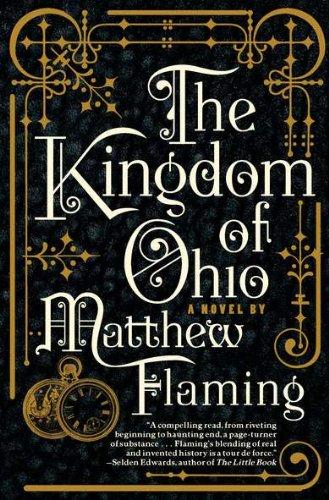
THE KINGDOM OF OHIO
After discovering an old photograph, an elderly antiques dealer living in present-day Los Angeles is forced to revisit the history he has struggled to deny. The photograph depicts a man and a woman. The man is Peter Force, a young frontier adventurer who comes to New York City in 1901 and quickly lands a job digging the first subway tunnels beneath the metropolis. The woman is Cheri-Anne Toledo, a beautiful mathematical prodigy whose memories appear to come from another world. They meet seemingly by chance, and initially Peter dismisses her as crazy. But as they are drawn into a tangle of overlapping intrigues,
After discovering an old photograph, an elderly antiques dealer living in present-day Los Angeles is forced to revisit the history he has struggled to deny. The photograph depicts a man and a woman. The man is Peter Force, a young frontier adventurer who comes to New York City in 1901 and quickly lands a job digging the first subway tunnels beneath the metropolis. The woman is Cheri-Anne Toledo, a beautiful mathematical prodigy whose memories appear to come from another world. They meet seemingly by chance, and initially Peter dismisses her as crazy. But as they are drawn into a tangle of overlapping intrigues, Peter must reexamine Cheri-Anne’s fantastic story. Could it be that she is telling the truth and that she has stumbled onto the most dangerous secret imaginable: the key to traveling through time?
Set against the mazelike streets of New York at the dawn of the mechanical age, Peter and Cheri-Anne find themselves wrestling with the nature of history, technology, and the unfolding of time itself.
- Berkley
- Paperback
- December 2010
- 336 Pages
- 9780425236949
About Matthew Flaming
Matthew Flaming was born in Los Angeles and studied philosophy at Hampshire College.
Praise
“A marvelous fable about the worlds beneath our feet and the conspiracies that turn our heads.”—Kirkus Review (starred)
“Absorbed by the twists and turns of the story, I felt like applauding every new idea, every conversation, every mystery, and every revelation! A memorable novel that makes me want to read much more of Mr. Flaming!” —Michael Moorcock
“A beautiful fable about love, time, technology, and the birth of America.”—Robert Anthony Siegel
Discussion Questions
Early in his story, Peter writers, “…even the details of this history are not certain, they still come closer to the truth than the recorded facts alone” (pg. 30). How did this affect your trust of Peter as a narrator? What do you think he means by this statement? In what ways do fact and fiction blur throughout the novel?
Peter tells of his life with his father on the frontier. In what ways were both men drawn to the wonders of technology? How was each man’s life affected by the modern inventions of their time?
Discuss Tobias’ breakdown in the tunnels. Why do you think he cracks? What is he responding to? How does what happens to Tobias change the way Peter sees the subway project, the people who are running the project, and the city around him?
What does the Brooklyn Bridge represent to Paolo, Peter, and the other subway workers? How do you think the bridge changed the psychological landscape of the citizens of New York City at the time it was built? Why was it such a marvel?
Why do you think Peter and Cheri-Anne drawn to one another? Why does Peter continue to help her even after she’s told him her story? What about her story would intrigue a man like Peter?
Peter and Cheri-Anne both come from motherless homes, and they both have fathers who are very influential in their lives. In what ways are their stories similar? How are they dissimilar? Do you think they actually have anything in common?
Cheri-Anne tells Peter, “We are both occupied by the same question: whether one can escape the past” (pg. 219). Do you agree with this? Are Peter and Cheri-Anne trying to escape the past? In what ways do they run from it, and in what ways are they trying to recapture what they’ve lost? What are emotions are they trying to reconcile?
Why do you think Peter tells his story in third person? What is he trying to distance himself from?
What do you make of the CROATOAN door, both the one in the tunnels and the one at the museum? Do you think that Peter can find Cheri-Anne? In the end, what are your theories about time travel in the novel? Where do you think walking through the door will lead Peter?
The author weaves many historical characters into this novel. How do you think using Edison, Morgan, and Tesla for characters added to the depth of the story? Did your views of America at this time in history change from reading this novel?
The novel begins with “Whether beautiful or terrible, the past is always a ruin.” Do you agree with this? Why or why not?
The author uses footnotes throughout. Do you think this added to the believability of the story he was creating? Was it clear to you what was fiction and what was nonfiction?
Of Nicola Tesla and Thomas Edison, it is Edison who history has been kinder to. After reading this book, do you think that recognition is well-earned?
